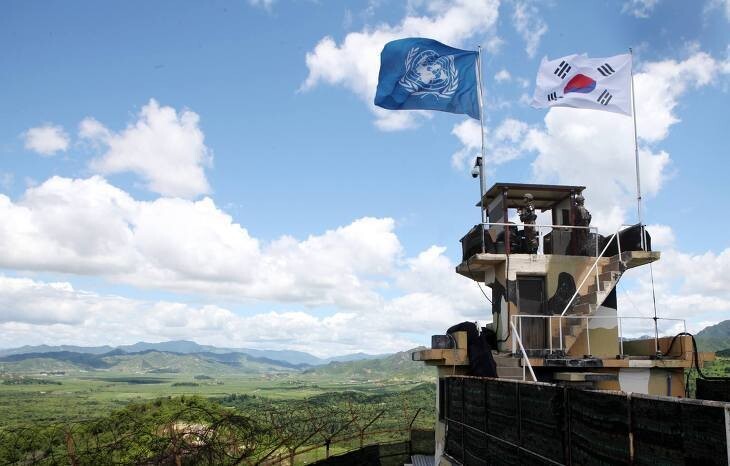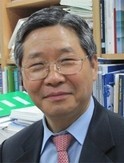hankyoreh
Links to other country sites 다른 나라 사이트 링크
[Column] The UNC’s time is up

In his New Year’s address for 2020, South Korean President Moon Jae-in announced plans for an independent inter-Korean cooperation effort to usher in an era of “individual tours” to North Korea in a bid to achieve a breakthrough in inter-Korean relations amid UN Security Council sanctions against the North. This was then fully contradicted by US Ambassador to South Korea Harry Harris, who said in a talk with the foreign press that Seoul’s policies for individual tours in the North needed to be discussed within the South Korea-US working group framework. To date, the UN Command and the US have obstructed South Korea’s efforts on numerous occasions to enter the DMZ to conduct inspections for the linkage of South and North Korean railways and roads or for other non-military purposes.
These kinds of remarks from the US ambassador and obstructions of inter-Korean exchange and cooperation efforts by UNC have been enough to infuriate South Koreans. The public has begun to catch on to the fact that the main reason inter-Korean agreements have not been implemented has to do with UNC and the US.
What are the legal issues surrounding UNC, and what sort of exit strategy might be developed for the future? To answer this question, we should first consider UNC’s history and legal standing.
After the Korean War broke out on June 25, 1950, the UN Security Council adopted Resolution 84 (S/1588) on July 7 of that year. This resolution assigned the name of “unified command” to the unit commanding armed forces deployed from 21 countries to aid South Korea, with the US government appointing its commander and permission granted to use the UN flag alongside the flags of the participating countries. The unified command was also required to report all of its activities to the UNSC. The unified command unit was formed the following July 24 in Tokyo. Without consulting with the UN, the US government changed its name to “United Nations Command” (UNC) and appointed Douglas MacArthur as its commander. The result was to give the appearance that the unified command represented the UN’s armed forces.
As the UNC headquarters were relocated to Seoul on July 1, 1957, the commander assumed the concurrent roles of USFK commander and commander of the South Korea-US Joint Chiefs of Staff Command. Seven UNC branches are currently in Tokyo, where they are to provide logistical support alongside the Japan Self-Defense Forces (JSDF) in the event of an emergency on the Korean Peninsula.
After the Korean War ended, then-South Korean President Rhee Syng-man refused to sign the Korean Armistice Agreement in 1953, leaving UNC as the only signatory on the South Korean side. On July 14, 1950 – 10 days before UNC was established -- Rhee transferred operational control for the South Korean military to the unified command (UNC). When the South Korea-US Combined Forces Command (CFC) was established on Nov. 17, 1978, the UNC’s operational command was transferred once again to the CFC, where it remains to this day.

As the only signatory from the South Korean side to the Korean Armistice Agreement on July 27, 1953, the UNC’s duties involve managing that agreement, preventing military clashes and acts of hostility, and spearheading a peace agreement. This is why the UNC holds authority to approve passage over the Military Demarcation Line (MDL) and entry to the DMZ. But now these duties of the UNC are posing a major obstacle to the effort of linking inter-Korean railways and roads. Rather than cooperating toward a peace agreement -- which should be its biggest responsibility following the Apr. 27 Panmunjom Declaration in 2018 -- it is instead finding faults with and hamstringing inter-Korean exchange and cooperation efforts. The same is true about its overzealous micromanagement of the DMZ.
The UNC’s reluctance to cooperate with inter-Korean exchange and cooperation efforts and its stringent controls on access to the region have their legal basis in the UNC and the US State Department’s refusal -- based on a UN resolution from Oct. 12, 1950 -- to recognize South Korea’s jurisdiction over the region north of the 38th parallel, and their sole recognition of the transfer of administrative authority on Nov. 17, 1954.
But in terms of the legal nature of the UNC, the official stance of the UN Secretariat is that it is unrelated to the UN, as it does not report any of its activities to the UN and is not subject to any UN controls. In an official response to a question about the UNC’s legal nature in 1994, the then UN secretary-general replied that it was not a lower-level UN institution, but an institution subject to US controls. Indeed, it is US military authorities who appoint officials in the command. This means that the US is wearing the “cap” of the UN Command, making use of it to sustain its vested interests.
The UNC is a multinational armed force under US leadership. The seven UNC branches in Japan provide an avenue for a renewed invasion of the Korean Peninsula by the JSDF in the event of an emergency on the Korean Peninsula. This is why the UNC should not be intervening excessively in inter-Korean exchange and cooperation efforts in non-military areas, even within the framework of UN sanctions.
Already, the dismantling of the UNC is being discussed at the international level. The command took a major hit to its prestige with the simultaneous passage of a North Korean resolution for its dismantling and a Western resolution opposing its dismantling at the 30th UN General Assembly on Nov. 18, 1975. Centrally, the first resolution proposing the UNC’s dismantling stressed the importance of replacing the armistice agreement with a peace agreement.
The key role of the UNC now is not to deter the North, but to aid the Korean Peninsula peace progress through its preservation and management of the armistice agreement.

In that sense, some are suggesting that one way out of the complex tangle of legal issues described above would be to replace the “UN Command” with “Republic of Korea” as a signatory to the armistice agreement, in keeping with the spirit of autonomy and peace in the Apr. 27 Declaration and contingent upon adequate discussions with the North. If the UNC does continue to hamper inter-Korean exchange and cooperation in the future, the most realistic approach may be for the UNC to shut down, assigning its duties as the armistice agreement signatory to the Republic of Korea. As a first step, South Korea and the US should officially establish a working group of experts to seriously examine this issue.
By Lee Jang-hie, professor of civil law at Hankuk University of Foreign Studies
Please direct comments or questions to [english@hani.co.kr]

Editorial・opinion
![[Editorial] Yoon must halt procurement of SM-3 interceptor missiles [Editorial] Yoon must halt procurement of SM-3 interceptor missiles](https://flexible.img.hani.co.kr/flexible/normal/500/300/imgdb/child/2024/0501/17145495551605_1717145495195344.jpg) [Editorial] Yoon must halt procurement of SM-3 interceptor missiles
[Editorial] Yoon must halt procurement of SM-3 interceptor missiles![[Guest essay] Maybe Korea’s rapid population decline is an opportunity, not a crisis [Guest essay] Maybe Korea’s rapid population decline is an opportunity, not a crisis](https://flexible.img.hani.co.kr/flexible/normal/500/300/imgdb/original/2024/0430/9417144634983596.jpg) [Guest essay] Maybe Korea’s rapid population decline is an opportunity, not a crisis
[Guest essay] Maybe Korea’s rapid population decline is an opportunity, not a crisis- [Column] Can Yoon steer diplomacy with Russia, China back on track?
- [Column] Season 2 of special prosecutor probe may be coming to Korea soon
- [Column] Park Geun-hye déjà vu in Yoon Suk-yeol
- [Editorial] New weight of N. Korea’s nuclear threats makes dialogue all the more urgent
- [Guest essay] The real reason Korea’s new right wants to dub Rhee a founding father
- [Column] ‘Choson’: Is it time we start referring to N. Korea in its own terms?
- [Editorial] Japan’s rewriting of history with Korea has gone too far
- [Column] The president’s questionable capacity for dialogue
Most viewed articles
- 1Months and months of overdue wages are pushing migrant workers in Korea into debt
- 2[Editorial] Yoon must halt procurement of SM-3 interceptor missiles
- 3Trump asks why US would defend Korea, hints at hiking Seoul’s defense cost burden
- 4[Guest essay] Maybe Korea’s rapid population decline is an opportunity, not a crisis
- 5At heart of West’s handwringing over Chinese ‘overcapacity,’ a battle to lead key future industries
- 61 in 3 S. Korean security experts support nuclear armament, CSIS finds
- 7Fruitless Yoon-Lee summit inflames partisan tensions in Korea
- 8First meeting between Yoon, Lee in 2 years ends without compromise or agreement
- 9[Column] Park Geun-hye déjà vu in Yoon Suk-yeol
- 10South Korea officially an aged society just 17 years after becoming aging society